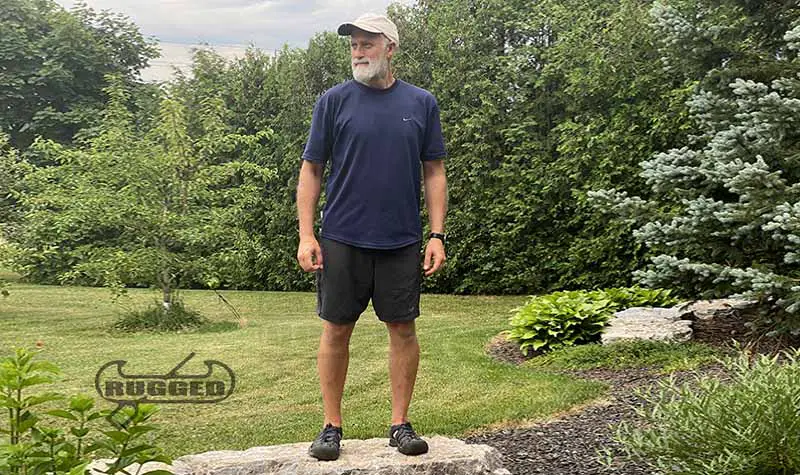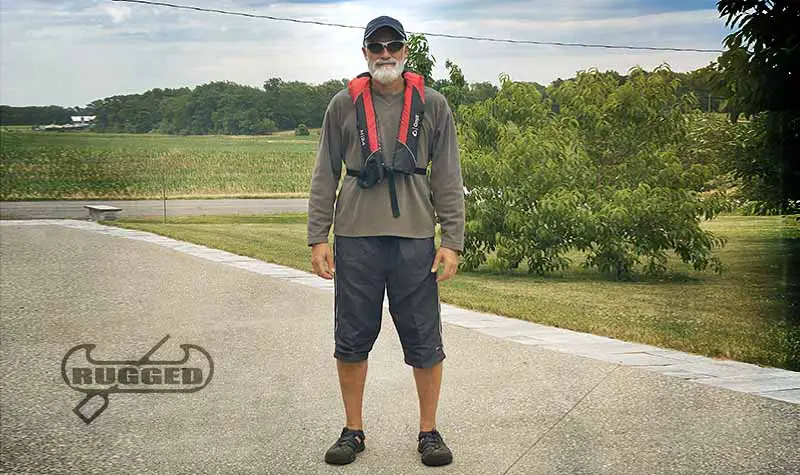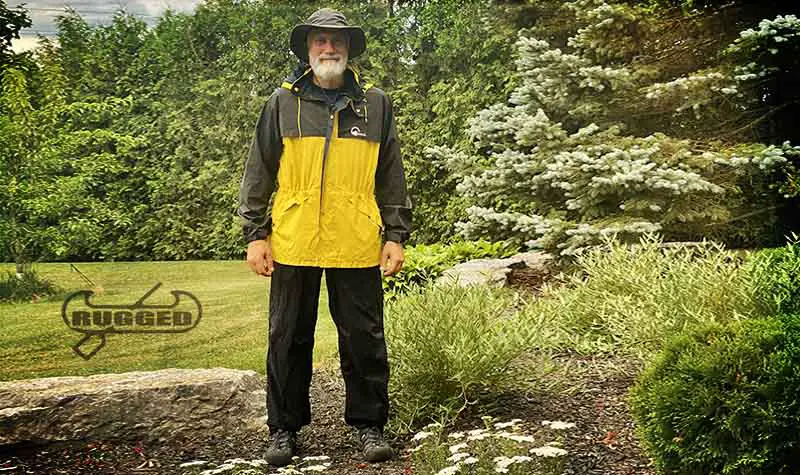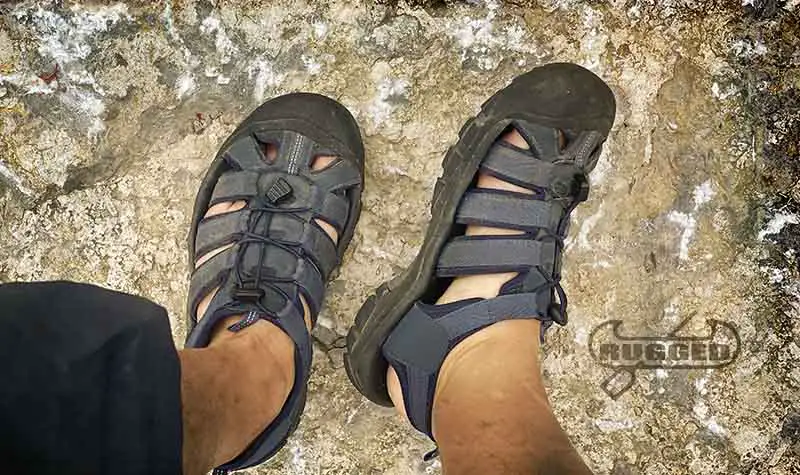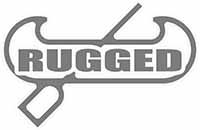The issue of what to wear while in your canoe has almost as many answers as there are canoeists! However, there are some accessories and apparel that are more or less understood as the better choice under a variety of conditions.
Generally, technical clothing that wicks away sweat is the best option for most types of canoeing. While in whitewater, it’s often best to wear a neoprene suit to protect from colder temperatures that will result from splashed water or a capsize.
After spending the better part of 40 years pushing a paddle through the water, I’ll offer you my insights into what hats, eyewear, shirts, pants, jackets, socks, and shoes are best under what types of conditions!
Table of Contents
Lake Tripping in the Summer
Lake Tripping is perhaps the most common type of canoe excursion, and according to the Outdoor Foundation, fully 77% of those in a canoe are out on a day trip.
The best clothing to wear on a warm day while canoeing is a quick-dry pair or shorts or pants along with a quick-dry technical shirt and/or light jacket, while also wearing a PFD, wide-brimmed hat, polarized sunglasses, and water shoes.
What to Wear in a Canoe on a warm day (rain or sun) for a day trip
If you’re out for a few hours of paddling, it’s often tough to know exactly what weather you’ll encounter. Because of this, I would strongly suggest bringing with you, any of the items I’ve listed below. If you don’t need some of them, you may need them if the weather changes or you get wet, so it’s a good idea to bring a dry bag (10L is adequate) for the extra items.
- Wide-brimmed hat OR baseball cap (but if you wear a baseball cap and have short hair, be sure to add sunscreen to the top of your ears.
- Polarized sunglasses (be sure they have UVA and UVB protection – which most do)
- Technical T-shirt made of a synthetic material like Nike’s “Dri-FIT” sweat-wicking material
- Windbreaker jacket OR rain jacket (which also doubles as a windbreaker)*
- Quick-dry shorts or hiking pants (the best contain a mix of Polyamide and Elastane)
- Water shoes (can be sandals or even Croc-style footwear for a few hours on the water)
*NOTE: Rain Jackets are typically made from a proprietary blend of materials that differs with each manufacturer. Columbia uses a material called Omni-Tech™, while Gore-Tex is another effective material that allows some degree of moisture to escape from your skin, while keeping rain out. Helly Hansen has a material they call HELLY TECH®, which is a mix of Polyester and Polyamide.
Less expensive jackets are made with a thin layer of polyethylene. They are very waterproof but they may increase your sweat retention so that you may feel damp inside your jacket even though rain is not making you wet.
What to Wear in a Canoe on a Colder Day Trip
Chilly days require a significantly different set of clothes, and after many years of practical experience, and many hours of research, here’s my best list of items you should have in a perfect scenario.
Please note that just because you don’t have all (or even most) of these items, that does not mean you should give up on paddling or take out a loan to buy gear. Use what you have and be creative, smart, and cautious!
- Toque or other warm hat (depending on how much hair you have, it may be a good time to hang up the baseball cap or Tilley hat, and get a light winter hat or tactical beanie.
- Technical T-shirt
- Fleece pull-over
- Windbreaker or rain jacket
- Merino wool or water-resistant trekking pants (usually made of Nylon and Elastane)
- Merino wool socks
- Hiking shoes or even running shoes like Salomon trail running shoes
Be sure your PFD can fit comfortably either inside or outside of any shirt or jacket you’re wearing. Most lifejackets are pretty comfortable (if they are made for paddling) but the one I use, makes me feel as though I’m not wearing a lifejacket at all!
This is my standard paddling PFD (made by Onyx), and I use it because it feels almost non-existent, AND I rarely fall in the water (well, never actually … by accident), so the need to re-charge the inflation canister is not an issue.
Don’t forget the small dry bag that can keep your extra items dry in case you need them during your day trip.
What to Wear on a Summer Canoe Camping Trip
Here’s where I can offer you the most insight that is based on personal experience. Many items of clothing will be common to a number of different canoeing scenarios but that’s to be expected. Here’s a list of what I would suggest (and why) as well as the items I would bring in my dry bag.
1 – Wide-brimmed hat with some rigidity
A hat like the Tilley Airflo will provide you with a substantial piece of headgear that can take wind without losing its shape or having the brim flip up in a strong gust. It is also designed for ventilation in the heat of Summer.
The wide brim protects your nose, lips, and ears from sunburn damage and some Tilley hats have storage for a small document inside the hat itself.
2 – Polarized Sunglasses with retainer lanyard or strap
Sunglasses are often the last thing canoeists think about when packing, and if a paddler remembers a pair, it will usually be any old pair used for driving, etc.
I suggest you take this piece of gear seriously since bright sun will be reflected off the surface of the water and into your eyes all day long. This can lead to serious migraine headaches (at least for me).
I prefer polarized lenses since they are usually UVA and UVB resistant, and they make the environment look even more idyllic than it really is! Don’t believe me? Try a pair. The sky looks bluer, the trees and grass look greener, AND the glare on the water’s surface is minimized so you can actually see beneath the surface.
3 – Sweat-wicking T-shirt or two, along with a pair of convertible cargo shorts that are also quick-dry and sweat-wicking
I own several pairs of convertible outdoor pants made of thin nylon that is quick-drying. The legs just above the knees can be unzipped and removed quickly and easily, leaving you with a pair of shorts.
Alternatively, you can have separate shorts and pants made of semi-stretchy, moisture-wicking, and quick-dry material.
Shirts are similar. Technical T-shirts made with wicking fabric (Nylon with Elastane, etc.) are the perfect shirt or (if it gets chilly) base layer with another long-sleeved shirt of the same material on top.
On a week-long trip, I’ll bring 2 T-shirts (I’ll wash them if necessary) and 1 or 2 technical long-sleeved pullovers.
I would also suggest (if you have room) it might be good to bring a fleece shirt for comfort at camp and to have as a backup if the temperatures drop significantly during the night.
4 – Windbreaker shell (jacket) AND a rain-proof jacket with hood
I’m a big fan of keeping warm and dry, so I bring a Columbia jacket that is a perfect windbreaker. It is not insulated but it is made of multiple layers and will repel a minimal amount of water. It lets my skin breathe and will not cause me to perspire without allowing the sweat to escape.
I also bring a polyethylene rain jacket that looks exactly like a windbreaker. If it’s raining hard and I’m on the water, I can keep mostly dry as long as I don’t wear it for a full day and do lots of strenuous activity.
5 – Rain-proof Pants
I own a pair of Nylon rain pants from Coleman that work pretty well. They have a polyethylene lining which makes them impervious to water. When coupled with my rain jacket, my whole body stays dry EXCEPT my feet which are usually in a pair of Keen sandals (closed-toe).
I can deal with wet feet in Summer conditions because they are easy to warm by a fire, and only my shoes are wet instead of all my clothing.
6 – Merino Wool Socks or Neoprene water socks
Merino wool socks offer something that cotton/polyester socks can’t. They are moisture-wicking, warm even when wet and they dry quickly. Unfortunately, they are quite expensive. This is one item of clothing you can add to your canoeing wardrobe over time as your budget allows.
A budget option that I don’t own but am curious about is a pair of water socks that come in lots of “flavors”. Some are made of neoprene and can protect your feet even without shoes. They aren’t waterproof, but your feet are protected from cold water and abrasions.
Other sock options come with a waterproof liner and you can wear them with sandals while still keeping your feet dry.
Admittedly, I do not have experience with every option available, but if your time and budget allow, it could be worth it to experiment with some options other than no socks or wool socks.
I usually bring 3 or 4 pairs on a trip (not all wool, unfortunately – no budget for that!)
7 – Sandals and Hiking Shoes
Footwear options vary greatly, and I’m not opposed to a good pair of trail running shoes if you plan on portaging quite a bit. However, with my limited budget, I bring only 2 pairs of shoes (plus I hate carrying more than I need to).
My main shoes for a Summer trip is a pair of Keen Drift Creek Closed-Toe Water Shoe Sandals. They’re tough, comfortable for long portages, protect my feet pretty well and the rubber sole won’t slip on the rocks.
The bad part is that they are expensive. I found mine at a thrift store (Value Village).
I also bring a pair of hiking shoes (I also have Scarpa hiking boots) for cooler weather and also for camp use if my sandals are soaked.
Lake Tripping in Colder Weather
Colder weather canoe trips require a bit of a specialized gear list especially as it relates to clothing. The dynamics of dealing with a capsize in cold weather is much different than warm weather.
In warm weather, you’ll be able to swim to shore in a bathing suit and make a fire (or even just spread things out on open rocky areas and wait for the sun to dry you and your gear.
In colder weather, you could actually get frostbite, hypothermia or worse! As such, my list of colder weather clothing is significantly modified from Summer canoe trips.
1 – Warm hat like a beanie or toque
A winter skiing beanie meets the description of the perfect cool weather paddling headgear. The tighter the knit the better and better still to have a lining of Polyester inside to really cut down on wind penetration.
Beanies also offer a perfect nighttime sleeping aid so your head won’t get cold.
2 – Warm Neck Gaiter
A neck gaiter can sometimes be used in hot weather to cool you down by wetting it, but if you don’t add water or you buy a fleece gaiter, it can be used like a cool-looking and functional scarf by protecting your neck from stray breezes and crosswinds in cool weather
3 – Base Layer of Technical T-Shirt with Fleece Pullover
For a shirt, I’d suggest the standard quick-dry and moisture-wicking synthetic fabric shirt next to your skin. If you have the cash, PLEASE get a Merino Wool base layer!
Then, I’d add another layer of the same but with long sleeves OR a heavy fleece sweater. This may be all that is needed on many Spring and Fall days through most of the Northern U.S. and most of inhabited Canada.
4 – Lined Windbreaker or light Winter Puffy Jacket
Any Winter coat would work for warmth, but you’ll want a jacket that is not overly bulky and large (which can be a serious hazard if you end up in the water).
I own several Columbia jackets that are basically windbreakers until you add the zip-in lining, after which the liner turns it into a functional Winter coat.
A puffy jacket is nice since it works like a very effective windbreaker while at the same time, it’s light enough to feel like you’re not even wearing it.
5 – Paddling Gloves
We suggest paddling gloves all year long, but especially during Autumn and Spring. While they don’t cover your fingertips, they do offer some level of warmth over no gloves at all.
Another great option for exclusively colder weather is a neoprene glove meant for water sports.
The paddling gloves, of course, are meant to help your grip on the paddle shaft, and they also help prevent blisters from long days of paddling.
The neoprene gloves help with grip and blisters too, but they also prevent excessive heat loss through your hands. They even work when wet based on the same principle as a wet suit.
6 – Cold Weather hiking pants or cargo pants with long underwear
Cold weather hiking pants are just a stretchy polyester or other synthetic material that is lined with a fleece interior. This is my preferred legwear.
However, it’s probably easier to get a good pair of long underwear (not cotton) under a pair of cargo pants. Remember, all fabrics should be as quick-dry as possible.
7 – Merino Wool Socks
Once again, wool socks carry the day. It’s hard to believe that after centuries of wool socks, there would be a newer, better technology for clothing, but the Merino wool is apparently impossible to mimic.
They are quick-drying, moisture-wicking, and durable. They also help eliminate odors!
8 – Hiking Boots
I own a pair of Scarpa Moraine hiking boots that use for cool-weather trips exclusively. They are lined, and fit with wool socks just perfectly.
However, once I’m at my campsite, I will either continue to wear them or if my feet are damp from rain, the lake or river, of from sweat, I’ll replace my socks and shoes with a pair of running shoes or sandals with socks.
Please note that in cold weather, it’s especially important to have a full change of warm clothing in your dry bag to avoid any emergencies that arise from having a fully soaked body and no way to get dry. That will put an end to your fun and you could find yourself in serious danger without a change of clothes and a way to stay warm and dry for the night.
Whitewater Trips in the Summer
On a warm-weather river trip with rapids, you’ll most certainly need you PFD at all times, and I would strongly suggest a NON-INFLATABLE life jacket. The likelihood of you capsizing on a whitewater trip is much higher than in quiet lake water.
If you capisize anywhere, you’ll need to have a PFD, but if it’s inflatable, it may be harder to deploy the inflation mechanism, and once you do, there is a cost to re-charging it. It’s much easier, safer and MUCH less expensive to just wear a ready-to-go paddling life vest on a river trip.
Unlike flat water trips in Autumn or early Spring, whitewater almost necessitates that a paddler wear some form of a wetsuit or drysuit to ensure safety from extreme temperatures. That said, here’s a general list of Whitewater clothing that DIFFERS from the Flat Water tripping clothing list:
A high-quality WRSI whitewater helmet – now is not the time to skimp on quality. You can do that with windbreakers, but not cranium protection!
1 – Whitewater helmet
A paddling helmet is always a smart piece of gear when running rapids for the same reason a bike helmet is a smart piece of gear for riding a bicycle. In fact, if your budget doesn’t allow for a paddling helmet, you can always use your bike helmet instead of foregoing a canoe trip because you don’t have all the specialized clothing and gear.
2 – Partial or Full Wetsuit
A wetsuit is an effective way to help stay warm if you capsize or get soaked. A wetsuit is designed to keep you warm ONLY when it is wet.
As long as the wetsuit is snug-fitting, a very thin layer of water is formed between your skin and inside of the wetsuit. Your body temperature quickly heats the thin water layer which then keeps you warm.
If your suit is too big and loose, the water between your skin and suit will be more, which means it won’t be as warm and it will likely be circulating in and out as you move. You’ll always have lots of cold water in your suit and that makes for a practically useless item of apparel.
3 – Neoprene Boots
Like a wetsuit, neoprene boots are not waterproof but help keep your feet warm when wet in the same way as described in item #2.
4 – Bathing Suit
While it’s not a bad idea to wear a quick-dry pair of shorts, it’s probably a better idea to wear a bathing suit instead. With shorts, you’ll likely need underwear (which are almost never “quick-dry”) while most bathing suits for both genders are definitely quick drying and you don’t need that extra layer of underwear.
Whitewater Trips in Colder Weather
Unlike flat water trips in Autumn or early Spring, whitewater almost necessitates that a paddler wears some form of a wetsuit or drysuit to ensure safety from extreme temperatures. That said, here’s a general list of Whitewater clothing that DIFFERS from the Flat Water tripping clothing list. These are items that can be ADDED to the items listed in the Whitewater Trips in the Summer section:
1 – Thin Neoprene helmet liner
This thin (often neoprene) accessory wicks sweat and can serve to keep you both warm (at night) and cool (soak it with water) during the day. Helmet liners are typically also quick-dry. Specifically, on cool days, it can take the bite out of wind gusts through your helmet, and it helps warm your head during cold nights.
2 – Either Full Wetsuit or (even better) a Drysuit
A wetsuit can help keep you warm enough to handle cold water and weather if you fall in by keeping a thin layer of water between your skin and the suit warm. However, you still have to get wet, which means when you get out of it, you’ll need to dry off quickly or risk getting very cold.
Drysuits keep your whole body dry, which is much nicer in cool weather, but they are more expensive. However, drysuits do not need to fit just right (snugly) like a wetsuit in order to work. Generally, you’ll be more comfortable in a drysuit if you can afford one.
Prices of drysuits can approach $1000 USD. If that wasn’t enough, because drysuits don’t offer a lot of insulation, there are base layers that you can purchase to make your drysuit experience more comfortable.
3 – Fleece mid-layer under your Drysuit
Most drysuits don’t have much insulation to help keep you warm (though some do) so you’ll have to wear a base layer (next to skin – like wicking material) followed by a mid-layer (typically fleece or other warm and comfortable material) before the top layer which is the drysuit itself.
Footwear for Canoeing
Shoes and socks for canoeing can vary greatly according to a paddler’s comfort levels and preferences. Because of this, it’s only fair that you know at least what your options are under a variety of conditions.
1 – Water Shoes
Water shoes is a term that describes a whole variety of shoes and sandals that are meant to get wet. Some materials dry quickly (like foam) but come with their own problems of poor sole grip and lack of durability.
Other materials are great for durability and grip, but they’re heavy, expensive, and take ages to dry. This is where your discretion is best used.
I use a variety of water shoes. I use a pair that looks much like a tennis shoe but it’s meant for water, I use a Croc-style shoe that fits more like a shoe than a Croc sandal, and I wear a Keen (or Keen-style) closed-toe sandal that has excellent traction on rocks.
2 – Neoprene Boots
Neoprene boots are a good option if you know you’ll be in contact with water much of the time as in a whitewater trip scenario. However, you’ll not want to walk around much with them on rocks or any terrain without a pair of rubber boots or protective outer footwear.
3 – Sports Sandals
Sandals like TEVA open-toed sandals are pretty comfortable but offer precious little protection, so I’d keep these sandals as camp shoes.
4 – Trail Running or Athletic Shoes
Running shoes (especially Trail shoes) are a good option for portaging and they’re great for protecting your feet from pine needles, gravel, dirt, and mud.
However, since your feet won’t breathe as well, you could be in for some sweat dampness, and foot odor unless you are VERY diligent in either keeping them dry, or drying them thoroughly when they’re damp.
5 – Socks
As a rule, most paddlers will have some type of socks with them for warmth and comfort at the campsite or even on the water. Most will have cotton/polyester socks from Costco or Walmart because they are affordable.
I would encourage you to save some pennies and get a good pair of full Merino Wood Socks though the price can be more than $50 for one pair (as opposed to $15 for 10 pairs of Costco socks).
As mentioned earlier in this article, Merino wool wick moisture, are warm even when wet and dry quickly. They are the gold standard of socks for any outdoor adventurer.
I keep my wool socks mostly for use at camp after the day is done. I typically paddle in warmer weather (I guess I’m getting soft!) so my feet are not usually uncomfortably cold during the day’s paddle.
Camp Clothing
Camp clothing is a topic or category of clothing that is often overlooked by inexperienced paddlers.
After some experience, most canoe campers will realize that the best clothing for paddling is not always the best clothing to relax in by the fire or sleep in.
There are many opinions and preferences as to what determines the “best” camp clothing, but here are my thoughts and ideas:
Pants can be the same as paddling pants and so can shirts. However, I bring a zip-up thin jacket that is NOT a wind-breaker, but a soft, stretchy, lined fabric like polyester. This is more comfortable than a semi-stiff windbreaker and offers warmth while sleeping.
My wool socks are a staple at the campsite, and my camp shoes are worn only at the campsite. I currently use a pair of foam sandals that look like a pair of sports shoes, except that they have holes everywhere like sandals and they are super-light because of their foam construction (like Crocs).
My headgear usually involves a sleeping hat which is a tight-fitting fleece liner-style cap, but you can use a light beanie to keep your head warm at night if you’re bald (like I sort of am).
Finally, my camp apparel also includes a pair of bug net gloves, a full bug jacket (including a hood with face net), and a separate wide-brimmed hat with 360-degree bug net to the shoulders.
For Sleeping
Maybe I’m just a minimalist guy, but I don’t bring special clothing for sleeping. I typically remove my jacket and sleep in my socks, pants/shorts and a long-sleeved pullover.
I also wear a toque since my head is not covered by my sleeping bag, and nights in Northern Ontario get cold even in mid-Summer.
What NOT to Wear on a Canoe Camping or Day Trip
If you don’t have the perfect wardrobe for the outdoors, it’s still better that you get out there at least to some extent rather than bemoaning the fact that you can’t afford all the “best gear” or clothing.
That said, you can actually equip yourself pretty well with basic wicking shirts, shorts and pants, as well as outdoor sports windbreakers and rain gear from thrift stores! YES, it’s possible because I’ve done it.
Take a trip to your local Value Village where I’ve built up my wardrobe with Columbia water-resistant windbreakers, my Chinook raingear, Keen sandals, trail-running shoes, wicking gaiter, and more!
Based on that, I’d strongly discourage clothing that is mostly cotton-based since it does not wick moisture (just holds on to it) and it’s ultra-slow drying.
I would also not suggest really old gear from the 1960s or 70s like I grew up with. Stay away from thick rubber rain suits (way too much sweating going on inside which is far less sanitary than never bathing on a canoe trip at all), and heavy canvas packs for storage.
Final Word on Hats and Sunglasses
A whole article could be written on outdoor hats alone, but in short, I don’t usually bring big headgear like my Tilly hats. While I do recommend them for those who love the look and function of them, I find I’m better served with a breathable set (yes I bring 2) of baseball-style caps. They offer sun protection on my face while sunscreen protects my ears.
One of my caps has a built-in set of 3 very bright LED lights that I use instead of a headlamp.
I also REALLY like the Outdoor Research Seattle Rain cap.
A wide-brimmed hat is also a bit awkward when it comes to wearing a raincoat. Most rain jackets have a hood, and that hood does NOT fit you well with a wide brim all the way around your hat. If your hat is waterproof, you may not need the hood, but it exists and it can only serve to catch rain as it falls from your hat.
If you prefer to remove your hood (if you can) or tuck it away and use a wide-brimmed rain hat, I like the Outdoor Research Seattle Sombrero.
I like to flip the hood right over my baseball cap while my brim keeps the front of the hood from falling down on my nose.
As far as sunglasses, I do recommend them, but I don’t like wearing them 100% of the time. I believe Vitamin D is synthesized by sun hitting your skin but also entering your eyes after being reflected from the environment around you (I don’t mean look at the SUN!!).
So, I recommend a pair of polarized sunglasses (which allow you to see under the surface of the water and also make everything look more colorful and vibrant on a sunny day).
I also recommend sunglasses that do NOT have a full-frame. I find that a full-frame impedes my vision on the edges. I much prefer a pair of shades that have no frame on the sides or bottom. Yes, it is true that without a hard, tough, polymer frame, glasses are more vulnerable to breakage, but I say just be very careful.
I use a pair of polarized shades from Strike King, and I have nothing negative at all to say about them even after 10 years!
Key Takeaway
Keep your paddling activities to those for which you can adequately equip yourself, and for most paddlers, that would probably be warm-weather flat water paddling of lakes (with or without portages).
Once you build up enough gear (including helmet, drysuit, etc.) you can tackle other scenarios that would be dangerous and foolish to try without the right clothing and gear.
ABOVE ALL, don’t be dissuaded from canoeing just because you lack all the techno-clothing! You can get decent gear if you’re discerning, at a local thrift store for a huge discount. I just bought a pair of gently used Scarpa Moraine mid-cut hiking boots at Value Village for $20 Canadian (that would be $15 USD). The retail price of the exact same shoes is $210 Canadian!


